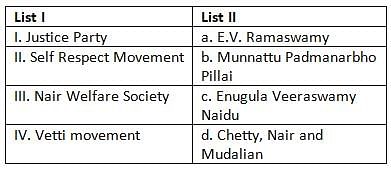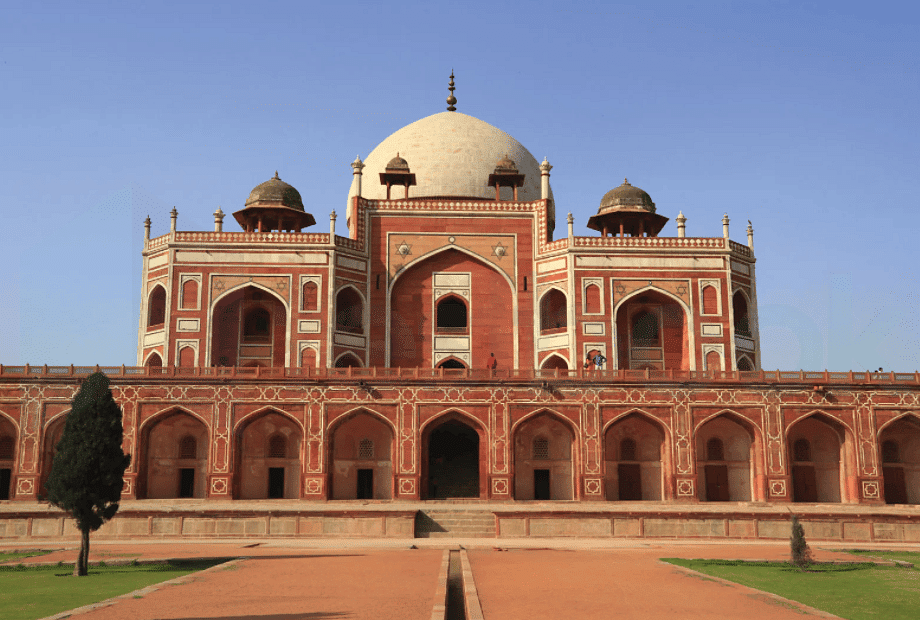UGC NET Paper 2 History Mock Test - 3 - UGC NET MCQ
30 Questions MCQ Test - UGC NET Paper 2 History Mock Test - 3
From which of the following sites of Haryana, evidences have been found for the first time regarding co-existence of the people of Late Harappan culture and Painted Grey Ware (PGW) culture?
Which of the following scholars is of the view that the discontent of the Brahmin community led to the downfall of the Maurya Empire?
| 1 Crore+ students have signed up on EduRev. Have you? Download the App |
Under the leadership of which leader did the Jats become very powerful after the death of Aurangzeb?
Which of the following statement(s) is/are correct?
1. The last Mauryan Ruler, Brihadratha was assassinated by his Commander-in-Chief, Pushyamitra Sunga.
2. The last Sunga King, Devabhuti was assassinated by his Brahmana Minister Vasudeva Kanva who ascended the throne.
3. The last Ruler of Kanva dynasty was deposed by Andhras.
Assertion (A) The most remarkable development in the religious field in India from the AD 6th century was spread of tantrism.
Reason (R) Tantrism arose as a result of the large scale admission of the aboriginal people in Brahmanical society.
Consider the following statements about the bhakti movement in South India.
1. The doctrine of bhakti was concentrated only among the rural sections of society.
2. The Bhakti saints opposed the varna system which led to the weakening of casteism.
Which of the above statements is/are correct?With reference to the Malwa School of painting, consider the following statements:
1. It flourished between 1600 and 1700 CE and is most representative of the Mughal courts.
2. Its three-dimensional simplistic language appears as a consummation of stylistic progression from the Jain manuscripts to the Chaurpanchashika manuscript paintings.
3. A large number of Malwa paintings discovered from the Datia Palace collection supports a claim for Bundelkhand as the region of painting.
4. Malwa School defies a precise centre for its origin and instead suggests a vast territory of Central India, where it got articulated with a sporadic mention of a few places, such as Mandu, Nusratgarh, and Narsyang Sahar.
Which of the statements given above is/are correct?
Which among the following was the primary cause of 1857 revolt?
With reference to the history of philosophical thought in India, consider the following statements regarding Sankhya school :
1. Sankhya does not accept the theory of rebirth or transmigration of soul.
2. Sankhya holds that it is the self – knowledge the leads to liberation and not any exterior influence or agent.
Which of the statements given above is / are correct?
With reference to the rise of Bengal, consider the following statements:
1. Bengal was the most fertile and the richest province of the Mughal Empire and included present-day Bangladesh and the states of Bihar and Odisha.
2. Bengal held economic importance for its famous textiles, silk, and saltpeter.
3. Exports from Bengal to Europe consisted of saltpeter, rice, indigo, pepper, sugar, silk, cotton textiles, handicrafts, etc.
Which of the above statement is/are correct?
Which of the following characterize or characterizes the town planning of the Harappan Civilization?
1. They possessed great palaces and temples.
2. The use of burnt bricks in the Harappan cities is remarkable.
3. The Drainage System of the Harappan Civilization was poor.
Which of the statements given above is/are correct?
The report ‘Journey through the Kingdom Awadh in the year 1849-50’ was written by-
Choose the correct statements.
1) In 1858 Lord Canning sent forth the royal proclamation in a grand Darbar at Delhi.
2) It was then proclaimed that all treaties and engagements of East India Company with princely states would be maintained and honoured.
3) The document was called “Magnacarta of the People of India”.
Tirthankara Parswanath’s idol is recognized by which symbol?
Balathal is an archaeological site located in:
The term ‘Rashtra’ first appeared in which of the following periods?
Who was the first Muslim to invade India in 712 AD?
Which ancient Indian book has been translated into 15 (fifteen) Indian and 04 (four) foreign languages?
Which of the following is the correct order of the Vedic literature?
Match List I with List II, and select the correct answer by using the codes given below the lists:
List - I
I. Lingayats
II. Alwar
III. Nayanar
IV. Advaita
List - II
a. Andal
b. Karaikkal Ammaiyar
c. Basava
d. Shankara
Codes:
Which of the following is / are correct statements about Sarojini Naidu?
She was first woman to become President of Indian National Congress
She was first woman to become the governor of an Indian state
She was awarded by British “Kaiser-i-Hind medal” for her contribution towards welfare of World War -I victims
Select the correct option from the codes given below:
Which act provided some share to Indians in the administration of their county?
Which among the following was/ were the objectives of the First Factory Act which was passed in 1881?
- It was enacted to improve the condition of the labour of factories
- Children of age group 9 to 12 were not allowed working more than 9 hours a day
- Inspectors were appointed to check safety measures
Choose the correct option from the codes given below :



















